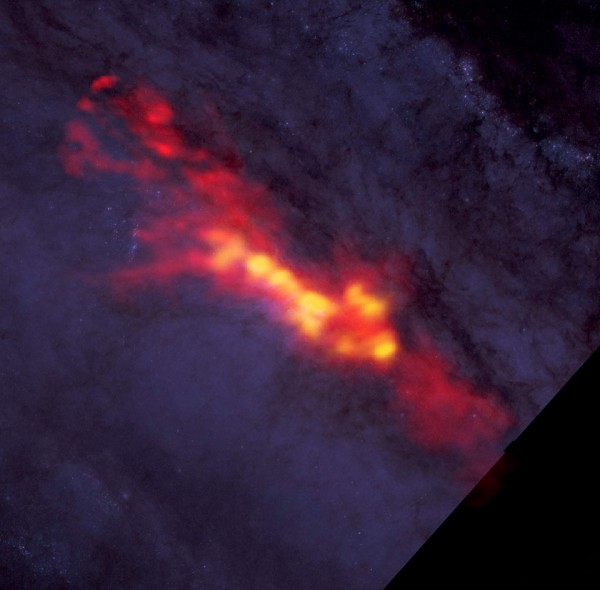How Starburst Galaxies 'Burst' With New Born Stars
| Ana Verayo | | Feb 17, 2015 08:13 AM EST |
(Photo : B. Saxton (NRAO/AUI/NSF); ALMA (NRAO/ESO/NAOJ), A. Leroy; STScI/NASA, ST-ECF/ESA, CADC/NRC/CSA) These new ALMA data reveal a diffuse envelope of carbon monoxide gas which surrounds stellar nurseries.
Researchers say a particular galaxy called the Sculptor Galaxy can provide clues as to what causes starburst galaxies to have an extra "burst".
This galaxy known as NGC 253 is one of the closest starburst galaxies near the Milky Way and is about 11 million light years away from our planet.
Like Us on Facebook
Starburst galaxies are unique since they churn out stars at a rapid rate 1,000 times faster than any family of stars found in the Milky Way. The Atacama Large Millimeter/submillimeter Array (ALMA) in Chile detected this star system and produced images from stellar nurseries inside the core of the Sculptor Galaxy.
According to Adam Leroy from Ohio State University, stars are normally formed via dense clouds of dust and gas. But scientists are still trying to figure out what kind of intense interstellar activity occurring inside starburst galaxies make them unique from other galaxies.
Massive, dense clouds of carbon monoxide were found in the region of NGC 253 where stars are born. Astronomers discovered different concentrations and some 40 different components in 10 regions inside this core of the galaxy.
These types of cloud formations offered clues that allow scientists to better understand how the galaxy was formed and what kind of conditions cause this highly active stellar formation to proliferate. The areas with the greatest star formation rate are those thought to be 10 times denser, hotter and more chaotic than similar clouds found in the Milky Way.
These dense regions are conducive for the high birth rate of stars as this type of galaxy makes starburst galaxies in a class of their own. They also contain different densities and chemical compositions compared to other galaxies.
Leroy adds that these starburst galaxies possess gas that's more effective in producing new stars. His team pulled apart the regions layer by layer to distinguish the gases that are efficient in star making.
Discovered in 1783 by astronomer Caroline Herschel, the Sculptor Galaxy is classified under disk shaped families of stars. Hubble focused on this object in 1998.
TagsHow Starburst Galaxies 'Burst' With New Born Stars, sculptor galaxy, ALMA telescope, Chile, NGC 253 galaxy, starburst galaxy, hubble, starburst galaxies sculptor galaxy burst baby stars new born
©2015 Chinatopix All rights reserved. Do not reproduce without permission
EDITOR'S PICKS
-

Did the Trump administration just announce plans for a trade war with ‘hostile’ China and Russia?
-

US Senate passes Taiwan travel bill slammed by China
-

As Yan Sihong’s family grieves, here are other Chinese students who went missing abroad. Some have never been found
-

Beijing blasts Western critics who ‘smear China’ with the term sharp power
-

China Envoy Seeks to Defuse Tensions With U.S. as a Trade War Brews
-

Singapore's Deputy PM Provides Bitcoin Vote of Confidence Amid China's Blanket Bans
-

China warns investors over risks in overseas virtual currency trading
-

Chinese government most trustworthy: survey
-

Kashima Antlers On Course For Back-To-Back Titles
MOST POPULAR
LATEST NEWS
Zhou Yongkang: China's Former Security Chief Sentenced to Life in Prison

China's former Chief of the Ministry of Public Security, Zhou Yongkang, has been given a life sentence after he was found guilty of abusing his office, bribery and deliberately ... Full Article
TRENDING STORY

China Pork Prices Expected to Stabilize As The Supplies Recover

Elephone P9000 Smartphone is now on Sale on Amazon India

There's a Big Chance Cliffhangers Won't Still Be Resolved When Grey's Anatomy Season 13 Returns

Supreme Court Ruled on Samsung vs Apple Dispute for Patent Infringement

Microsoft Surface Pro 5 Rumors and Release Date: What is the Latest?










